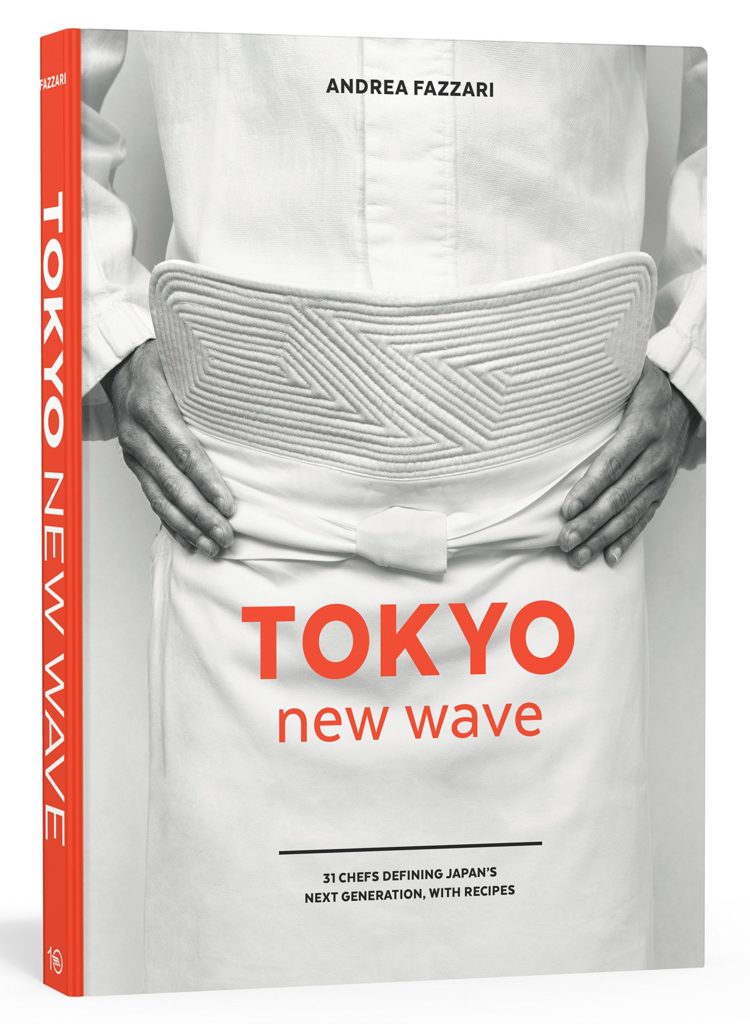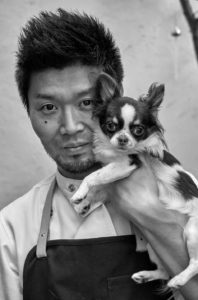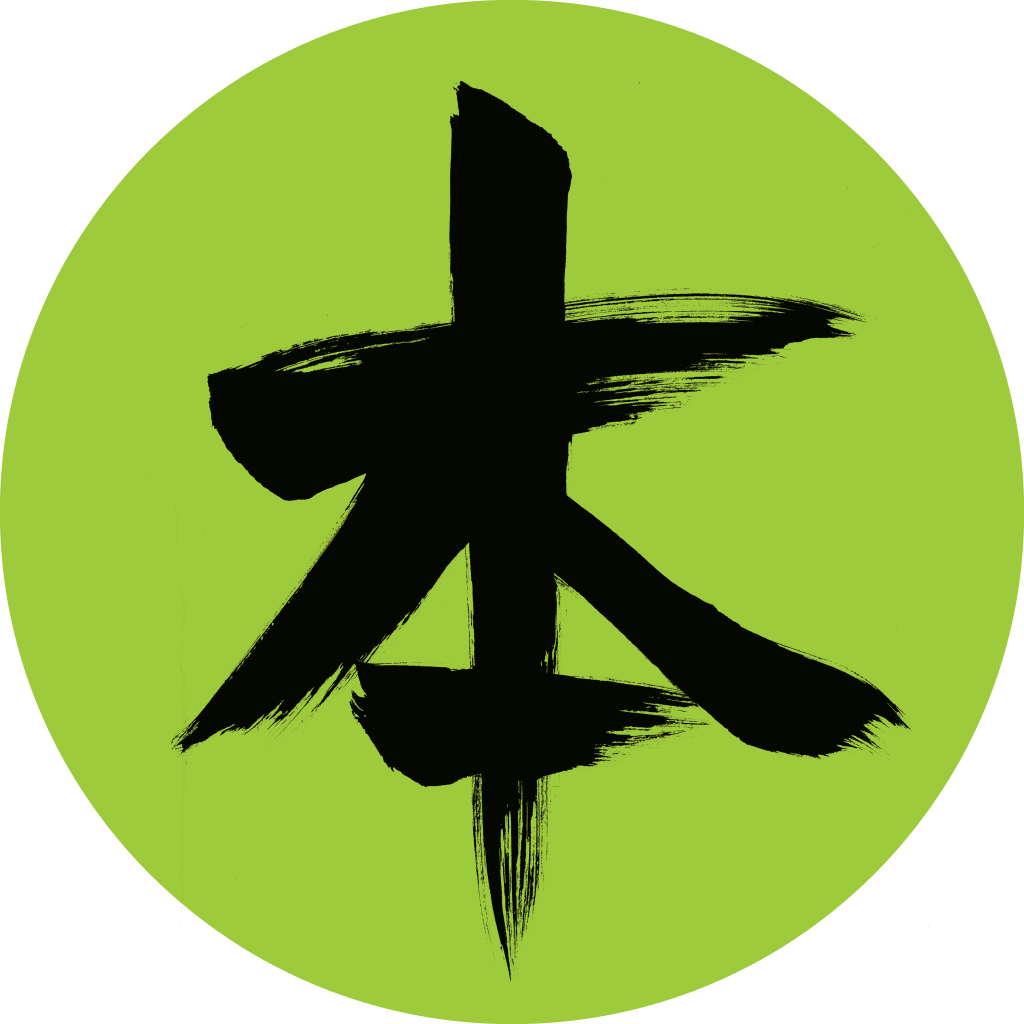

In Tokyo New Wave, Andrea Fazzari explores the changing landscape of food in Tokyo, where a young and charismatic generation is redefining what it means to be a chef in this celebrated food city. Open to the world and its influences, these chefs have traveled more than their predecessors, have lived abroad, speak other languages, and embrace social media. Yet they still remain distinctly Japanese, influenced by a style, tradition, and terroir to which they are inextricably linked. This combination of the old and the new is on display in Tokyo New Wave, a transporting cookbook and armchair travel guide that captures this moment in Japanese cuisine and brings it to a savvy global audience.
This 304-page book is Andrea’s love letter to Japan and the country’s distinct philosophy and approach to food. It includes 435 of her photographs, her insights, interviews, and chef recipes. As a Tokyo-based author and dining consultant, Fazzari is an insider in the city’s food scene, working regularly with Tokyo’s many influential and respected chefs.

Sample interview: Zaiyu Hasegawa, of “Den”
Zaiyu is a unique name. What is its origin?
One of my relatives is a Buddhist priest, and he named me Zaiyu, which means “to do good things and to help others.” When Japanese Buddhists pass away, they receive a new name for the afterworld. In my case, I can use the same name in the afterworld because a priest gave me my name.
Why do you cook?
I love seeing people eat and enjoy my food. In my experience, there are a lot of nice places to eat, but I can never actually remember what I ate. I remember the restaurant more if it makes me feel something. So I wanted my own restaurant to give people a feeling, an experience.
Guests respond strongly to your welcoming style here at Den. Did you set out to develop a style of hospitality that feels like eating with family?
I grew up in a large family, but today’s families are smaller. People care less about—and for—others. When I was a child, my family and neighbors tried to teach me about life and raise me. I treat my staff like family. I am always thinking about Team Den—if we are all well, if everyone is happy. My employees and customers are a part of an extended family.
What is your favorite place or town to visit in Japan and why?
I like going to the mountains in general, but specifically Fuji-san [Mount Fuji], so I can forage wild mushrooms.
What was your childhood like?
My mother was very hardworking. She was a geisha, and even when she worked late, she always prepared a nice meal for me and my siblings. I always felt taken care of. She made things like miso soup, gyoza, rice, hamburger, and even beef stroganoff.
Whenever I would see my mother dressed a geisha, she was a totally different person. She was transformed. She would not talk to me. I’m the second child, so I had to take care of my youngest brother and sister. Because of this, I cooked from a young age, making them fried rice, nigiri [a slice of fish over vinegared sushi rice], sandwiches, and Japanese spaghetti.
What is your earliest food memory?
My mother introduced me as omiyage, a kind of bento box that she would bring home from elaborate kaiseki (haute cuisine) meals. She would surprise us with these gorgeous, tasty little gifts when we woke up in the morning. It was so exciting! It was after eating one of these omiyage that I began to think about cooking as a profession. I was twelve or thirteen years old. By high school, I knew I wanted to be a chef.
For you, what does it mean to be Japanese?
I think that Japanese people consider and think about other people more. When Japanese people have a given goal, I think they try to assess how the decision will affect others in their lives. I also think that Japanese people are not good at being direct. There are good and bad aspects of being Japanese, and I realize that when I am in other countries I need to act a bit differently. If I say whatever is on my mind to just everyone, I’m afraid I will hurt people’s feelings.
Do you have future plans or goals?
I do think about the future, especially for children. I hope children will think about becoming chefs. Now young people don’t think about becoming chefs so much. For children in Japan, it’s hard to go to Japanese restaurants. In the future, I’d like to create more opportunities for children to cook and learn about food in Japan.
What is your favorite word?
Fun.
Sample Recipe!
UNI IN SOY BÉCHAMEL SAUCE
Uni comes from the sea, while yuba comes from the soil. The idea behind this dish is to play on the creamy texture that they both share, despite coming from different sources.
SERVES 4
- ¼ cup soy sauce
- ¼ cup sake
- ¼ cup mirin
- 28 yellow or orange pieces of soft, creamy uni (sea urchin), at room temperature
- 8 dark yellow pieces of firm uni, at room temperature
- 3½ tablespoons unsalted butter
- ¼ cup flour
- 2 cups soy milk
- 1⅔ cups heavy cream
- Sea salt
- 3 ounces fresh yuba sheets
- Dab of freshly grated wasabi root or small ball of wasabi paste
In a medium bowl, mix together the soy sauce, sake, and mirin. Add the two types of uni, toss gently, and marinate at room temperature for 5 minutes, then drain.
Melt the butter in a saucepan over low heat. Stir in the flour and continue to cook the mixture for about 10 minutes, until little bubbles appear. Add the soy milk, a little at a time, stirring constantly, so that no lumps form. Bring the mixture to a boil, stirring constantly with a whisk, until the mixture thickens and becomes glossy, about 5 minutes. Remove from the heat. Stir in the heavy cream and season with a pinch of salt.
To finish, cut the yuba into bite-size strips, place it in four serving bowls, and then pour the cream mixture over the yuba. Put seven soft uni in the center of the mixture. Place two pieces of the firm uni on top of each serving, and then garnish the uni with some wasabi. Serve right away.
NOTE: Fresh yuba sheets (also known as tofu skin) can be purchased at Japanese grocers. Uni comes packaged in a box, no cleaning needed, and can be found at high-end seafood markets and Japanese markets. Ask for the highest grade for this preparation and buy the freshest uni possible. If there is no expiration date, make sure the uni has bright color and is in nice plump lobes. Uni can vary in softness, and you will need one firm type and one softer type for this recipe. Ask your fishmonger for assistance.
Complete list of the 31 chefs and restaurants covered in Tokyo New Wave:
- Zaiyu Hasegawa / Den
- Hiroyasu Kawate / Florilège
- Shinobu Namae / L’Effervescence
- Hiroyuki Sato / Sushi Tokami
- Yosuke Suga / Sugalabo
- Koji Koizumi / Kohaku
- Lionel Beccat / Esquisse
- Kentaro Nakahara / Sumibiyakiniku Nakahara
- Toshifumi Nakahigashi / Erba da Nakahigashi
- Shuzo Kishida / Quintessence
- Takaaki Sugita / Sugita
- Satoshi Kakegawa / Äta
- Yoshiteru Ikegawa / Torishiki
- Yoshiaki Takazawa / Takazawa
- Hayato Takahashi / Pellegrino
- Kan Morieda / Salmon & Trout
- Fumie Takeuchi / Sushi Take
- Susumu Shimizu / Anis
- Yusuke Namai / Ode
- Yuji Tani / House
- Kotaro Meguro / Abysse
- Yoshihiro Hiraoka / Kamachiku
- Shinya Otsuchihashi / Craftale
- Makoto Konno / Organ
- Takao Ishiyama / Sushiya
- Kuniatsu Kondo / Owan
- Daisuke Tsuji / Convivio
- Shinsuke Ishii / Sincère
- Daisuke Kaneko / L’As
- Yuki Onishi / Japanese Soba Noodles Tsuta
- Jinnosuke Umehara / Yakumo Saryo
About the Author: Andrea Fazzari is the photographer and stylist of L’Aperitivo, shot entirely on location in Italy. She is Starwood Hotel Group’s first Luxury Collection Global Explorer; her photographs, journal entries and audio narration of her travels on six continents are featured on the Luxury Collection website and in the Luxury Collection Destination Guides. She is a tastemaker in Hotel Stories, a travel book which showcases unique luxury properties around the world, and the featured photographer for the book Bvlgari Il Ristorante, photographed in Japan.
She is the recipient of the Lowell Thomas Gold Award for Travel Photography and Photo District News featured her as one of the year’s best cookbook photographers in PDN’s Food Issue for 2017.
